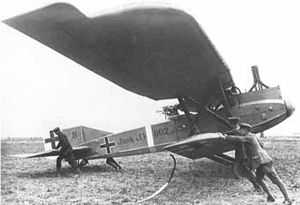Junkers J.I Video - Picture

|
|
Junkers J.I
J.I

Role: Observation and liaison aircraft
Manufacturer: Junkers
Designed by: Otto Mader
First flight: 28 January 1917
Introduction: 1917
Retired: 1918
Primaryuser: Luftstreitkrx¤fte
Number built: 227
The Junkers J.I (manufacturer's designation J 4, not to be confused with the earlier, pioneering J 1 all-metal monoplane of 1915/16) was a German "J-class" armored sesquiplane format warplane of World War I, developed for low-level observation and Army cooperation. It is especially noteworthy as being the first all-metal aircraft to enter mass production. It was a slow aircraft, but its metal construction and heavy armour, which comprised an extremely advanced, single-unit armoured "bathtub" that ran from just behind the propeller to the rear crew position, and acted both as the main fuselage structure and engine mounting setup in one unit, was an effective shield against anti-aircraft artillery.
Development
Picture - The only complete surviving Junkers J.I
The experimental developments were interrupted by the breakout of World War I in August 1914. In May 1915, Junkers achieved a test order for the further development of his all-metal aircraft by the German War Ministry, when delegates of this Ministry visited the Dessau "Jco" (Junkers Company) plants. In September 1915, the production of the J 1 pioneering all-metal monoplane prototype began at Dessau, and at the beginning of December 1915, the first Junkers aircraft was finished.
Operational history
It was well-liked by its crews, although its ponderous performance earned it the nickname "Furniture Van". The aircraft first entered front service in August 1917. They were used on the Western Front during the Kaiserschlacht {Kaiser's Battle} of March 1918. The production at Junkers works was quite slow due to poor organization and monthly output was low. There were only 227 J.Is manufactured until the production cease in January 1919 (part of them, after hostilities). Although a number were lost primarily to landing accidents, none were apparently lost in combat, a tribute to its tough armoured design.
Operators
German Empire
Luftstreitkrx¤fte
Survivors
Only one relatively complete aircraft survived, bearing German military serial number J.I 586/17 and preserved at the Canada Aviation Museum in Ottawa. Two fuselages exist, one at the Science & Technology National Museum in Milan, Italy, and another at the Deutsches Technikmuseum Berlin.
Specifications
General characteristics
Crew: Two, pilot and observer
Length: 9.1 m (29 ft 10 in)
Wingspan: 16.00 m (52 ft 6 in)
Height: 3.4 m (11 ft 2 in)
Wing area: 49.4 m² (531 ft²)
Empty weight: 1,766 kg (3,893 lb)
Gross weight: 2,140 kg (4,718 lb)
Powerplant: 1 x— Benz Bz.IV, 149 kW (200 hp)
Performance
Maximum speed: 155 km/h (97 mph)
Range: 310 km (193 miles)
Service ceiling: 4,000 m (13,123 ft)
Armament
1 x— trainable, rearward-firing 7.92 mm (.312 in) Parabellum MG14 machine gun
Junkers
Comparable aircraft
AEG J.I
AEG J.II
Albatros J.I
Albatros J.II
Taylor, Michael J. H. (1989). Jane's Encyclopedia of Aviation. London: Studio Editions. pp.538.
Jane's All the World's Aircraft 1919, p. 320a-321a
World Aircraft Information Files. London: Bright Star Publishing. pp.File 898 Sheet 01.
Junkers J1 at the Canada Aviation Museum
Grosz, P.M. Junkers J.I, Windsock Datafile 39. Hertfordshire: Albatros Productions Ltd., 1993. ISBN 0-948414-49-9
Living Warbirds: The best warbirds DVD series.
Source: WikiPedia